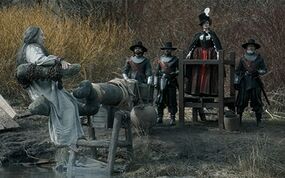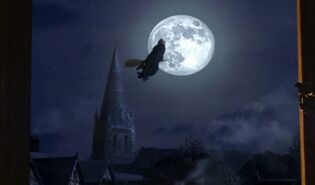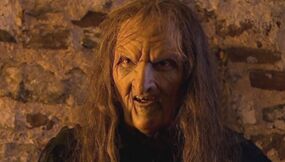Witch: Difference between revisions
mNo edit summary |
Borisashton (talk | contribs) No edit summary Tag: 2017 source edit |
||
| Line 72: | Line 72: | ||
=== Cultural depictions === | === Cultural depictions === | ||
[[William Shakespeare]] wrote about witches, ([[TV]]: ''[[The Shakespeare Code (TV story)|The Shakespeare Code]]'') featuring them in his play, ''[[Macbeth]]''. ([[PROSE]]: ''[[The True | [[William Shakespeare]] wrote about witches, ([[TV]]: ''[[The Shakespeare Code (TV story)|The Shakespeare Code]]'') featuring them in his play, ''[[Macbeth]]''. ([[PROSE]]: ''[[The True Tragedie of Macbeth (short story)|The True Tragedie of Macbeth]]'') | ||
[[Arthur Miller]] wrote a play entitled ''[[The Crucible]]'' based on the Salem [[witch trial]]s. ([[PROSE]]: ''[[The Witch Hunters (novel)|The Witch Hunters]]'') | [[Arthur Miller]] wrote a play entitled ''[[The Crucible]]'' based on the Salem [[witch trial]]s. ([[PROSE]]: ''[[The Witch Hunters (novel)|The Witch Hunters]]'') | ||
Revision as of 02:14, 21 October 2021
A witch was a practitioner of magical arts. The term was often primarily applied to female magicians, though not all female magicians considered themselves witches. Some cultures used the term "wizard" to refer to a male witch (TV: The Dæmons) while others used "witch" to refer to practitioners of either gender. Less advanced cultures had a fear of witches and would sometimes mistake psychic powers or advanced technology as witchcraft.
A benevolent witch was known as a "white witch". (TV: The Dæmons) In Orkney, Scotland, a witch could be referred to as a "spey-wife". (AUDIO: The Revenants) A group of witches was called a coven. (TV: Image of the Fendahl)
Common attributes
A witch practised witchcraft. In folklore, witches were known for flying on broomsticks (TV: The Smugglers) and cackling. (TV: The Shakespeare Code) They were also capable of casting spells, (TV: Invasion of the Dinosaurs) which they recorded in their grimoires. (HOMEVID: Ghosts of Winterborne, White Witch of Devil's End)
Witches on Earth
Alien entities, the Fendahl (TV: Image of the Fendahl) and the Dæmons (TV: The Dæmons) undoubtedly affected humanity, specifically human notions of witchcraft.
When a soldier from 1916 was sent to 1535 by a Weeping Angel, his appearance was witnessed by a crowd and he was burned as a witch. (COMIC: The Weeping Angels of Mons)
In 1899, Henry Gordon Jago and Professor George Litefoot had an encounter with witches. Jago was able to defeat them with his large vocabulary. (AUDIO: The Carrionite Curse)
Persecution on Earth

During the 17th century in Europe, fear of witchcraft was the pretext for the trial and state-approved murder of many innocents. (TV: Image of the Fendahl) This was the same in the United States. (PROSE: The Witch Hunters)
In Britain, Parliamentary Witch-Prickers investigated potential witches. (AUDIO: The Witch from the Well) These hunters included Matthew Hopkins, the self-styled Witchfinder General. (COMIC: Witch Hunt) Those denounced as witches faced trial. One such ceremony was A Tryal of Witches at the Assizes, held in London in the 17th century. (TV: The Woman Who Lived)
Suspected witches were tied up and had fruit thrown at them. (AUDIO: The Witch from the Well) The Bible instructed not to allow witches to live. (AUDIO: Winter for the Adept) Several Witchcraft Acts were passed by governments prohibiting its practice. Suspects of witchcraft were bound and thrown into a pond. If the suspect sunk and drowned, they were considered innocent. If he or she floated, however, they were found guilty and were executed. One way or another, the suspect would die. (AUDIO: Plague of the Daleks) The ducking stool was a similar method of punishment. (AUDIO: The Devil's Armada) Witches could also be burned at the stake (TV: Invasion of the Dinosaurs) or hanged. (PROSE: The Witch Hunters) Jamie McCrimmon, a Scottish Highlander from 1746, noted that witches were sprinkled with holy water. (TV: The Moonbase) In Britain, the last Witchcraft Act was not repealed until 1951. (TV: The Dæmons)
History of witches in Britain
13th century
In March 1215, Turlough found himself locked up as a witch for supposedly conjuring up demons in the court of King John of England. (TV: The King's Demons)
16th century
When Ashildr, an immortal human, cured a whole village of scarlet fever, the villagers believed she was a witch and attempted to drown her. (TV: The Woman Who Lived)
In London during July 1553, when Mistress Ellen and Queen Jane Grey witnessed Rani Chandra return to her own time via a time window, Ellen believed it witchcraft, but Jane believed Rani to have been an angel. (TV: Lost in Time)
In 1588, Mistress Pincham, the midwife in Sissenden Village, was thought to be a witch and punished. (AUDIO: The Devil's Armada)
In London, 1599, three Carrionites planned to use William Shakespeare's play, Love's Labour's Won, to free their race and establish a "Millennium of blood". The Carrionites were witch-like creatures who used voodoo and "spells" to kill their victims. (TV: The Shakespeare Code)
17th century
In the 17th century, Agnes Leech was accused of being a witch. Matthew Hopkins came to find Agnes and framed her. Clara Oswald convinced a mob that Hopkins was the witch, not Agnes. (COMIC: Witch Hunt)
Becka Savage falsely accused many women in Bilehurst Cragg of being witches, including the Thirteenth Doctor. (TV: The Witchfinders)
20th century
The Third Doctor once encountered a peasant who had been sent to 1970s London by a time eddy. The peasant claimed that a witch had cast a spell on him and that he was going to tell the priest so he could have her burned. (TV: Invasion of the Dinosaurs)
Martha Tyler lived in Fetchborough, 1977. She was locally painted as a white witch, knew the ancient traditions and possessed second sight because of Fetch Priory's time fissure. Locals deferred to her and called her "Mother Tyler" as a symbolic sign of respect. A genuine coven of malign witches, led by occultist Maximillian Stael, also lived in the area and plotted to resurrect the Fendahl. (TV: Image of the Fendahl)
Olive Hawthorne was a white witch who lived in Devil's End in the 1970s or 1980s. (TV: The Dæmons)
In Moreton Harwood in 1981, Sarah Jane Smith and K9 encountered witches who worshipped Hecate. (TV: A Girl's Best Friend)
Aggie was a white witch who gave Sarah Jane Smith some heather to use as protection against a demonic pig spirit. (PROSE: The Sow in Rut)
21st century
Around the early 21st century, the leader of the Ravens kidnapped Christine and Demi Jenkins and attempted to summon a daemon from the past. (COMIC: Ravens)
Above London in 2006, the Sycorax leader regarded the Doctor as a practitioner of witchcraft when he saw him regrow his hand after his cut it off. The Doctor told the Sycorax that he was a Time Lord. (TV: The Christmas Invasion)
History of witches in the United States
17th century
The Salem witch trials were the trials of supposed witches in Salem Village between 1692 and 1693. In June 1692, Susan Foreman found herself accused of witchcraft in Salem Village. Tituba, Rebecca Nurse, John Proctor and Elizabeth Proctor were all falsely accused of witchcraft by Reverend Samuel Parris and hanged. (PROSE: The Witch Hunters)
20th century
Mathilda, also known as the Witch of Buena Vista, distributed Blue Moonbeams in San Francisco in 1967. (PROSE: Wonderland)
Elsewhere on Earth
In 785, the Council of Paderborn outlawed the belief in witches, which began a period of time lasting until the 12th century where witch trials didn't occur. (AUDIO: The Book of Kells)
Peril Bellamy, a student at the Tremayne Academy, Switzerland, in 1963, was telekinetic. She and her ancestors were often accused of being witches. Miss Tremayne overheard this fact and threatened her with a butcher's knife. (AUDIO: Winter for the Adept)
Cultural depictions
William Shakespeare wrote about witches, (TV: The Shakespeare Code) featuring them in his play, Macbeth. (PROSE: The True Tragedie of Macbeth)
Arthur Miller wrote a play entitled The Crucible based on the Salem witch trials. (PROSE: The Witch Hunters)
The Time Lord Marnal wrote The Witch Lords during his time on Earth. (PROSE: The Gallifrey Chronicles)
The Lion, the Witch and the Wardrobe was a book (PROSE: Question Mark Pyjamas) written by C. S. Lewis. (COMIC: The Professor, the Queen and the Bookshop)
Sabrina the Teenage Witch, featuring the eponymous Sabrina, was an American TV series aimed at teenagers which aired in the early 2000s. (PROSE: I Was a Monster!!!)
Harry Potter was a series of books by J. K. Rowling, (TV: The Shakespeare Code) which included Harry Potter and the Philosopher's Stone. (TV: The End of the World) PQ Rowling, a descendant of J. K., later wrote Harry Potter and the Half-Moon Dentist. (PROSE: Doctor Who and the Adaptation of Death)
Elsewhere in the universe
Though not precisely a witch, the Seeker on Ribos appeared to serve a similar cultural function. (TV: The Ribos Operation)
On Talderun, a cult of witches led by Jal Dor Kal worshipped Shara's relic. These witches were all killed when the relic was removed and the temple collapsed. (AUDIO: Nekromanteia)
Evil witches from throughout the universe held a gathering on the planet Vargo that was led by the Grand Witch. The Second Doctor posed as a wizard to scare off most of the witches, then dealt with the remaining Grand Witch. (COMIC: The Witches)
Across space, the Travellers of the 26th century, who had originated on Earth, honoured ancient gods and conducted rituals. The Travellers used puterspace as a way to experience mystic realities without drugs. (PROSE: Love and War)
Brimo, a woman from the planet Nefrin long before the formation of the Earth, adopted a witch-like persona. (COMIC: Doctor Who and the Time Witch)
The Carpalian Witch was a spider-like witch whom the Doctor and Donna once met. (PROSE: The Doctor Trap)
In the 28th century, the Catholic Church branded Time Lords witches after a malfunctioning TARDIS materialised on Haven and exploded. The Seventh Doctor was accused of witchcraft after his TARDIS materialised in a Haven marketplace. (PROSE: Companion Piece)
References
The Witch and Whirlwind was a pub on Dellah frequented by Bernice Summerfield. (PROSE: Dragons' Wrath) Straggly Witch was the name of a loch in Scotland. (AUDIO: Enemy Aliens)
The Witch of the Well was a name given to the Caliburn Ghast - a ghost haunting Caliburn House. (TV: Hide) The Eleventh Doctor later called through a time fissure to Clara Oswald using this name, who scared Elizabethan soldiers by threatening to turn them all into frogs. (TV: The Day of the Doctor)
During World War II, the all-female 588th Night Bomber Regiment of the Soviet Air Force was nicknamed the Night Witches by the Germans. The Regiment adopted the name, understanding it could inspire fear within their enemies. (AUDIO: The Night Witches)


